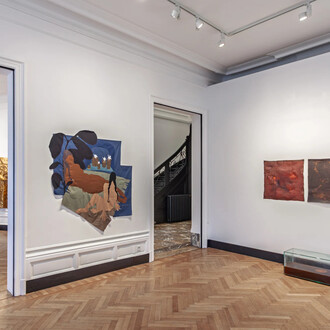Galerie Templon, who has been working with Claude Viallat since 1973, is presenting a series of previously unseen works by the artist in its Brussels space. Les echelles de Nîmes highlights a lesser-known side of the founder of the Supports/Surfaces movement’s work, the pieces playing with volume and space, far from all conventional representations of how art is displayed.
Yves Michaud recalls that Claude Viallat ‘often paints on surfaces that are actually flattened or enlarged envelopes of spaces.’ In Les echelles de Nîmes, moving between positive and negative, canvas straps and emptiness, Claude Viallat’s unmistakable signature small bone shape is no longer evenly painted. With these pieces, the artist once again explores the theme of the ladder, an element (painting or object, made of rope, canvas or gauze) that links ground to wall, often used in the Supports/Surfaces movement, particularly by Daniel Dezeuze.
The name of the series refers to the artist’s Echelles de Venise from 1976, a period when Claude Viallat’s artistic approach became more complex: the material is broken up by an assemblage of fabrics with a variety of origins, the support and its seams dictating the composition and structure of the canvas.
Created in Nîmes – where the artist was born in 1936 and continues to live and work – the new pieces show the extraordinary vitality, the unstoppable creative urge of an artist who works in his studio every day. The exhibition provides yet another demonstration of Claude Viallat’s ability to reinvent himself: he works from that same, always identical abstract form he has been repeating for fifty years, in a ceaseless process where the support plays a determining role, yet every painting is unique.
Claude Viallat is one of the founders of the Supports/Surfaces avant-garde artistic movement that emerged in the early 1970s, propounding both art theory and politics. Figures in the movement included Vincent Bioulès, Louis Cane, Daniel Dezeuze, Jean-Pierre Pincemin and Noël Dolla. They called for a fresh approach to art that questioned traditional materials such as the canvas and the stretcher. Viallat began working on industrial tarpaulins without stretchers, covering them with the same endlessly-repeated abstract shape. Reproduced using a stencil, in a variety of colours and on different surfaces (upholstery fabrics, rugs, recycled materials), the motif eradicates the notion of “subject” and enables Claude Viallat to explore the meaning of the creative gesture and the status of the work of art.
Claude Viallat has been a leading figure on the contemporary art scene for the last fifty years. He represented France at the Venice Biennale in 1988. Today, Claude Viallat is an artist who cannot be ignored. His approach is all the more current in the light of the emergence of a new movement in American art that is examining his heritage (low-status materials, repetitions, the error as operating principle, exploring new surfaces) as well as the renewed interest in vernacular and artisanal practices evident in international contemporary art. His works are featured in numerous public collections, including at the Musée National d’Art Moderne de la Ville de Paris, Mnam - Centre Pompidou, and Moma in New York. The Musée Fabre in Montpellier held a major retrospective of his work in the summer of 2014. A major installation Claude Viallat first created in 1982 will be exhibited this year at Art Basel Unlimited 2018.
















